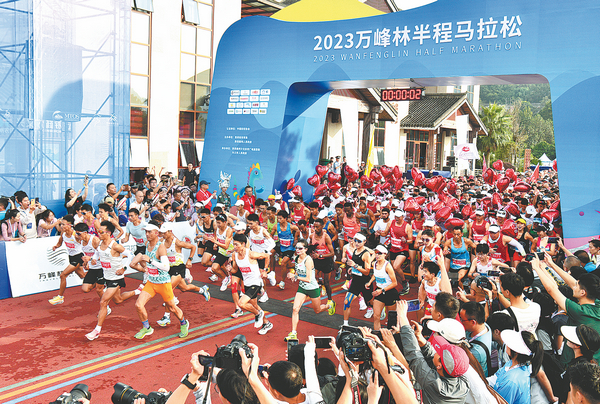

There are now a range of cultural and tourism experiences on offer, including distinctive homestays, blossom sightseeing, farming, camping under the stars, fruit picking and art festivals.
Su Qiuyan is glad that she made the bold decision to open a homestay in Wanfenglin at the beginning of last year, when everything was still in the grips of the COVID-19 pandemic.
"Choosing to run a homestay during uncertain times was not just a matter of passion but also a belief in the allure of mountain tourism in Qianxinan," Su says, adding that she believes in the great potential for future development.
Since July, her homestay, with nine guest rooms, has been pretty much booked up, and the bookings are now flowing in after the National Day holiday, she says.
Su says she was amazed by the magnificent, perilous and secluded landscapes the first time she visited the autonomous prefecture about 18 years ago.
It was quite different from her coastal hometown in Fujian province.
The charming, leisurely lifestyle convinced her to start her own tourism career in the prefecture and for over a decade, she has seen the rise of mountain tourism.
"In the past, Qianxinan was hidden deep in the mountains, only known to a few. Although the scenery was beautiful, there were very few tourists," she recalls.
"Nowadays, an increasing number of scenic areas have emerged, and each attraction is bustling with tourists. The tourism industry is becoming ever more diversified, with facilities and services continuously improving," she adds.
The area can become a fertile ground for the homestay industry, she predicts.
By 2022, the number of AAAA-level scenic spots in Qianxinan had grown to 13, up from two in 2016, and 30 AAA-level sites emerged in the same period.
Accommodation development has been a priority, with the building of several five-star hotels and more than 400 homestays that together offer around 100,000 beds.
Hundreds of tourism projects have sprung up, ranging from rural restaurants to handicrafts and specialty stores and businesses.
With the prefecture's rising fame as a mountain destination, facilities such as hotels, restaurants, air links, shopping and accommodation are becoming increasingly complete, says Ran Xingpu, secretary-general of the Qianxinan tourism industry association.
The association has conducted a series of activities to spice up this year's mountain and outdoor sports event, including intangible cultural heritage exhibitions and Bouyei opera performances.
"Local people are benefiting from tourism in terms of entrepreneurship, employment and travel," Ran says.
Yu Jian, who was born and bred in Qianxinan, has benefited from rising tourism.
He has been a tour guide at multiple mountain-based tourist attractions in the prefecture for five years.
He is now working at Malinghe Canyon, about a 40-minute drive north of Wanfenglin.
The canyon packs in visitors all year round, who come for the landscape that varies with the seasons.
"It takes about two-and-a-half hours to tour Malinghe Canyon, and more tourists have shown up during the summer vacation period," Yu says.
The most common feedback he has received is that travel in Qianxinan is a slow-paced enjoyment, and there's no need to rush through an itinerary. "I have to shuttle back and forth two to three times every day. Sometimes, I walk more than 37,000 steps in a day," Yu says.
"As more visitors come, we continue to improve our services. Our explanations have also evolved, from just introducing the scenic area at first, to covering various aspects of the tourist experience in Qianxinan, including dining, accommodation, transportation, shopping and entertainment," he adds.
Local authorities have trained staff involved in the tourism sector, especially before the International Conference of Mountain Tourism and Outdoor Sports.
The endeavors have led Qianxinan's tourism income to surge from 11.2 billion yuan ($1.54 billion) in 2016 to 29.8 billion yuan last year, and tourist visits from 15.3 million to 32.8 million, according to local authorities.
For the first seven months of this year, the prefecture received 24 million traveler visits and raked in 22 billion yuan in tourism revenue, recovering to the levels seen before the pandemic in 2019.
Wang Qiao, deputy director of the prefecture's culture, sports, radio, television and tourism bureau, says more effort will go into making the prefecture an international mountain tourism destination and a top-tier domestic resort.
"This will unleash the benefits of mountain tourism and outdoor sports, stimulate cultural and tourism consumption potential, drive the development of integrated tourism, and effectively connect the achievements of poverty alleviation with rural vitalization, ensuring the sustained and high-quality development of our region," Wang says.
Zhao Yandi contributed to this story.
Contact the writers at yangfeiyue@chinadaily.com.cn